The Construction Resource Management Process Explained
-
Sapna
- June 27, 2024

Efficient resource management in construction is essential for completing projects on schedule, within budget, and meeting quality standards. This comprehensive guide will delve into the intricacies of construction resource management, examining both its operational and strategic elements, and provide best practices and templates to optimise the process.
Table of Contents
What Is Construction Resource Management?

Construction resource management involves the strategic allocation and optimisation of resources—including labor, materials, equipment, and time—throughout a construction project’s lifecycle. This process is essential for managing resources effectively, minimising waste, reducing costs, and maximising efficiency.
Operational Construction Resource Management
Operational construction resource management focuses on the day-to-day allocation and utilisation of resources on construction sites. This includes scheduling labor, tracking equipment usage, and ensuring materials are available when needed. Effective operational management ensures that projects run smoothly on a daily basis.
Strategic Construction Resource Management
Strategic construction resource management, on the other hand, involves long-term planning and forecasting. This includes identifying future project resources needs, developing procurement strategies, and creating contingency plans. Strategic management aims to align resources with project goals and timelines to prevent delays and cost overruns.
Types of Construction Resources
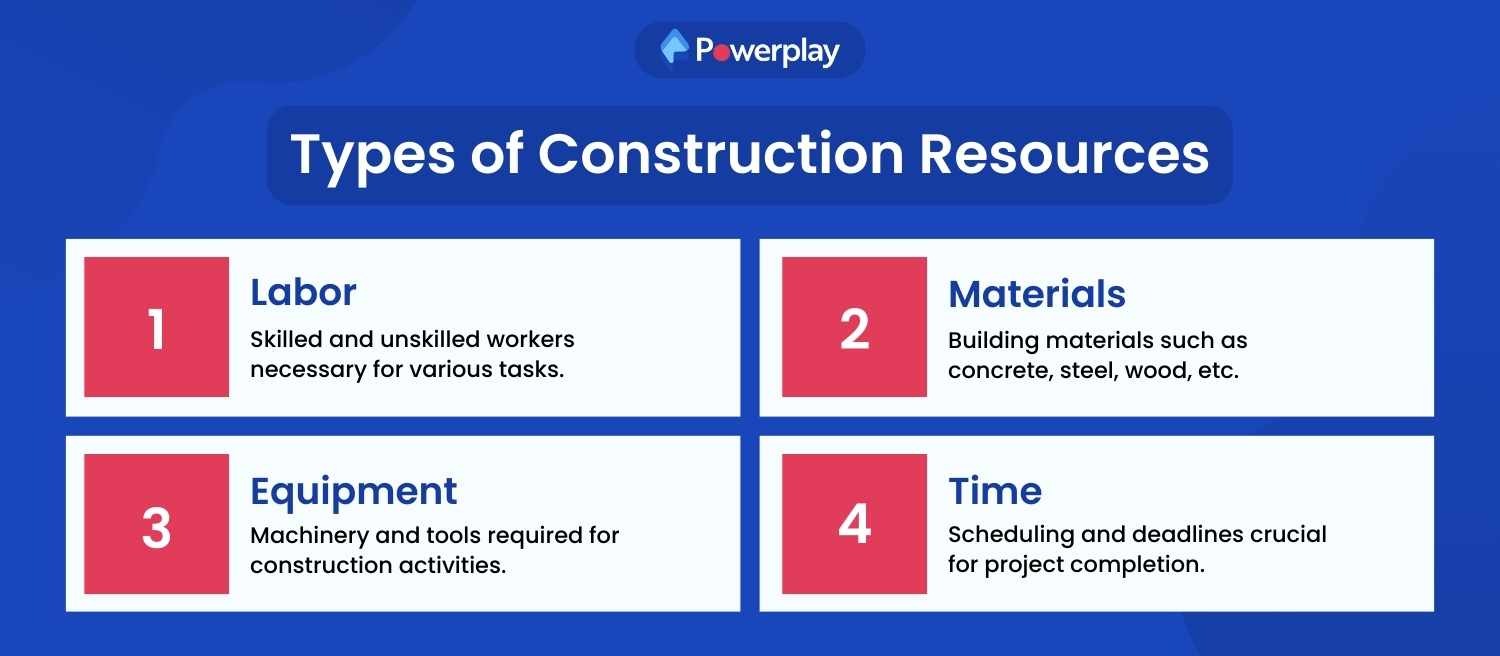
- Labor: Skilled and unskilled workers necessary for various tasks.
- Materials: Building materials such as concrete, steel, wood, etc.
- Equipment: Machinery and tools required for construction activities.
- Time: Scheduling and deadlines crucial for project completion.
Benefits of an Effective Construction Resource Management
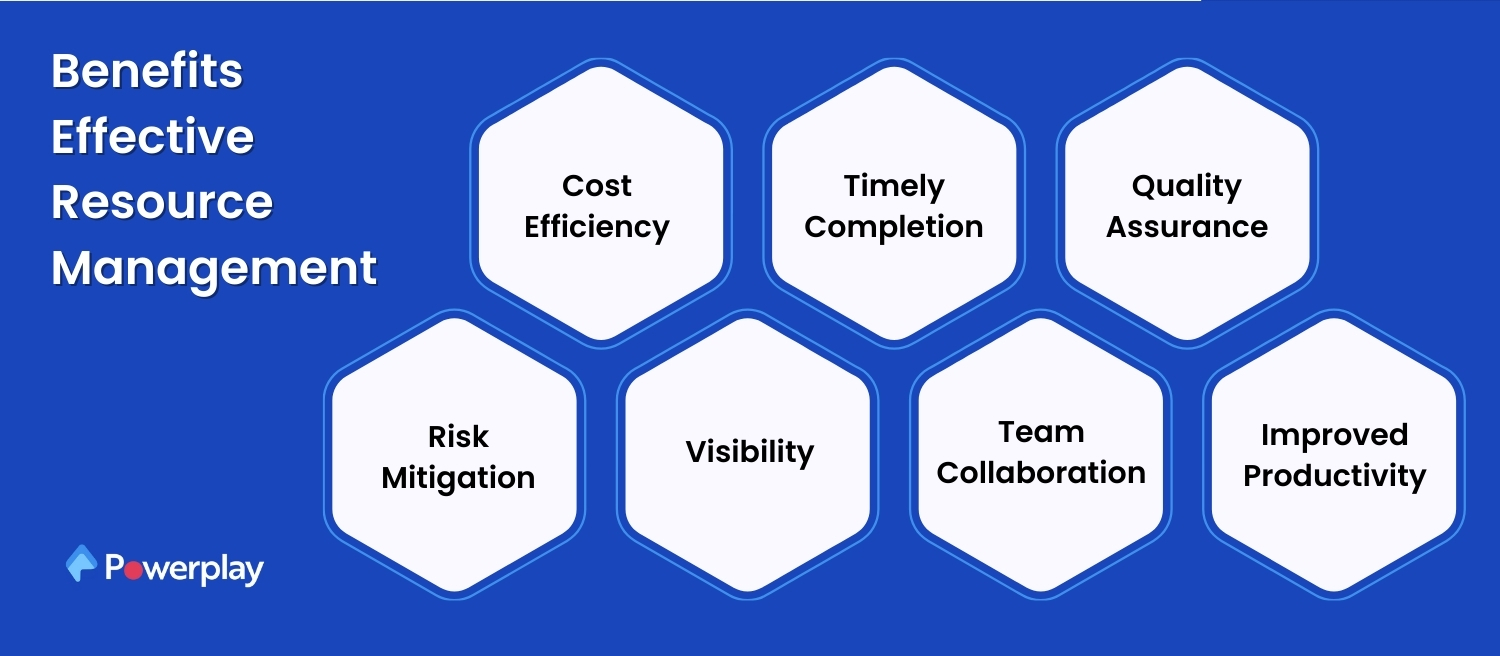
Effective construction resource management brings numerous advantages to any project, ensuring smooth operations and successful outcomes. Here are the key benefits:
Effective management of project teams can streamline scheduling, ensure optimal resource allocation, prevent trade stacking and idle time, and increase the use of valuable assets while reducing wastage.
Cost Efficiency
One of the primary benefits of effective construction resource management is cost efficiency. By strategically planning and allocating resources, construction managers can significantly reduce wastage of materials, labor, and equipment. Here‘s how it works:
- Precise Resource Allocation: By accurately determining the necessary resources for each phase of the project, managers can avoid over-ordering or under-utilising materials and equipment.
- Bulk Purchasing: Effective planning allows for bulk purchasing of materials, which often comes with discounts, thus reducing overall costs.
- Minimising Idle Time: Proper scheduling ensures that labor and equipment are utilised efficiently, minimising downtime and associated costs.
- Avoiding Last-Minute Purchases: Advanced planning reduces the need for urgent, often more expensive, last-minute purchases.
By reducing wastage and ensuring that expenditures align with the budget, effective resource management helps keep projects financially on track.
Timely Completion
Meeting project deadlines is crucial in construction, as delays can lead to increased costs and bad client relationships. Effective construction resource management ensures timely completion of projects through:
- Accurate Scheduling: By creating detailed schedules that account for every aspect of the project, managers can make sure that tasks are completed in the correct sequence and on time.
- Resource Availability: Ensuring that the necessary resources are available when needed prevents work stoppages and delays.
- Contingency Planning: Effective management includes contingency plans for potential delays, such as bad weather or supply chain disruptions, allowing for quick adjustments to the schedule.
- Real-Time Tracking: Utilizing project management software to track progress in real-time helps identify potential delays early, so corrective actions can be taken promptly.
By adhering to timelines, construction managers can maintain project momentum and meet deadlines, leading to increased client satisfaction and potentially more business.
Quality Assurance
Quality is utmost important for the success of construction projects. Good resource management ensures that the right construction resources are used correctly, which enhances the overall quality of the project:
- Qualified Labor: Ensuring that skilled labor is available and properly assigned to tasks that match their expertise guarantees high-quality workmanship.
- High-Quality Materials: Effective management includes sourcing high-quality materials that meet project specifications, which directly impacts the durability and safety of the construction.
- Proper Equipment Use: Making sure that the right equipment is available and used correctly by trained personnel ensures efficiency and quality in execution.
- Regular Inspections: Routine checks and quality control measures help identify and rectify issues early, maintaining high standards throughout the project.
Quality assurance through effective resource management leads to projects that not only meet but often exceed client expectations.
Risk Mitigation
Identifying and addressing potential resource-related issues early can prevent significant problems down the line:
- Proactive Risk Assessment: Regular risk assessments help identify potential issues such as resource shortages, supplier reliability, and equipment failures.
- Flexible Resource Plans: Having adaptable plans allows for quick changes in response to unforeseen circumstances, such as delays in material delivery or sudden labor shortages.
- Supplier Management: Establishing robust relationships with dependable suppliers guarantees a steady material supply and minimises the risk of delays.
- Contingency Resources: Keeping a buffer of critical resources can help mitigate the impact of unexpected shortages or issues.
By identifying risks early and having strategies in place to address them, construction managers can avoid costly disruptions and keep projects on track.
Visibility
Visibility in construction resource management refers to the ability to monitor and track the usage of resources throughout the project lifecycle. Here’s how it benefits project management:
- Real-Time Monitoring: Construction projects involve dynamic and often unpredictable resource needs. With real-time insights, managers can track the utilisation of materials, equipment, and labor as tasks progress. This visibility allows them to intervene promptly in case of over-utilisation, under-utilisation, or unexpected resource demands.
- Optimisation Opportunities: By having a clear view of resource utilisation, managers can identify areas where resources are being inefficiently used or where there are bottlenecks. For example, they can redistribute resources to balance workloads, adjust schedules to avoid overbooking equipment, or streamline processes to reduce wastage.
- Data-Driven Decision Making: Visibility provides actionable data that informs decision-making. Managers can use historical data and real-time analytics to forecast future resource needs more accurately, allocate resources effectively, and mitigate risks associated with resource shortages or overages.
Team Collaboration
Effective team collaboration is essential for achieving project goals in construction. Here’s how construction resource management facilitates collaboration:
- Centralised Communication: Resource management tools provide a centralised platform where project teams, stakeholders, subcontractors, and suppliers can communicate and collaborate. This ensures that everyone is working with the same up-to-date information and reduces the risk of miscommunication.
- Task Assignment and Tracking: Clear visibility into resource availability enables efficient task assignment and tracking. Project managers can assign tasks based on resource availability and skill sets, ensuring that the right team members are deployed to the right jobs at the right time.
- Real-Time Updates: Construction projects often involve multiple teams working concurrently on different tasks. Real-time updates on resource availability and task progress allow teams to adjust their plans and coordinate effectively. For example, if a delay occurs due to resource unavailability, affected teams can be notified promptly to reschedule their activities.
Improved Productivity
Improving productivity in construction involves maximising output while minimising input, including resources like labor, materials, and equipment. Here’s how effective resource management enhances productivity:
- Optimised Resource Allocation: By accurately forecasting resource requirements and scheduling resources accordingly, managers can prevent underutilisation or over-utilisation of resources. This optimisation ensures that resources are deployed efficiently, reducing idle time and maximising productivity.
- Workflow Efficiency: Streamlined resource management processes simplify workflow management. For instance, automated scheduling tools can sequence tasks based on resource availability and dependencies, minimising delays and optimising workflow continuity.
- Reduced Downtime: Efficient resource allocation reduces downtime caused by resource shortages or conflicts. When resources are allocated based on project priorities and real-time needs, workers spend more time on productive tasks and less time waiting for materials, equipment, or instructions.
Challenges Associated with Construction Resource Management and How to Mitigate Them
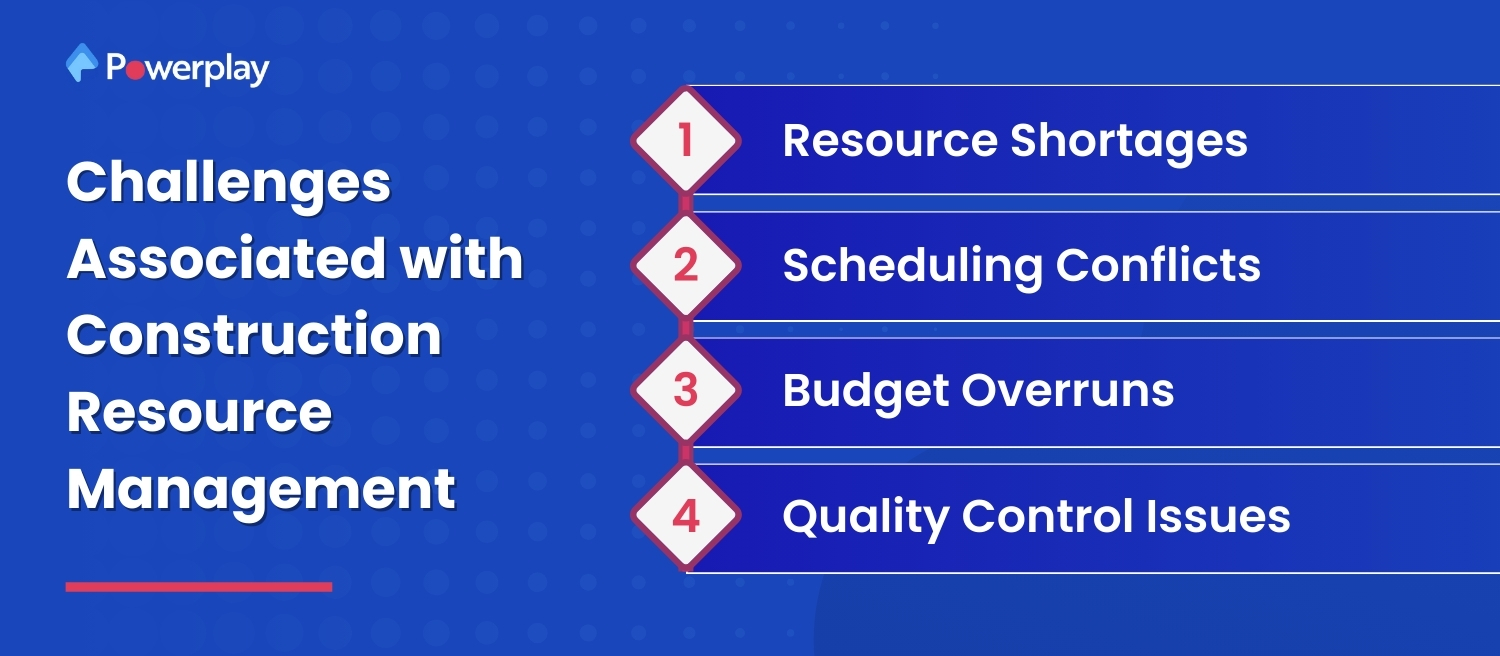
Effective construction resource management is essential for the success of any construction project. However, it comes with its own set of challenges. Understanding these challenges and knowing how to mitigate them is crucial for ensuring smooth project execution. Here are some common challenges and their solutions:
One of the significant challenges in construction is the shortage of skilled workers. Human resources play a critical role in resource management, and the lack of skilled professionals can severely impact project timelines and quality.
Resource Shortages
Challenge: Resource shortages can severely impact the progress of a construction project. This could include shortages in materials, labor, or equipment. Such shortages can halt work, leading to delays and increased costs as managers scramble to procure the necessary resources at possibly higher prices.
Mitigation:
- Maintain a Buffer Stock: Always keep a buffer stock of critical materials to prevent work stoppages. This means having a reserve of essential items that can cover unexpected shortfalls.
- Develop Strong Supplier Relationships: Establishing strong relationships with dependable suppliers can ensure a consistent supply of materials. Long-term partnerships with suppliers can also provide benefits such as priority service, better prices, and flexibility during high-demand periods.
- Forecasting and Planning: Use historical data and market analysis to forecast future resource needs accurately. This proactive approach can help in anticipating shortages and planning accordingly.
Scheduling Conflicts
Challenge: Scheduling conflicts can arise when there is poor coordination between different tasks and resource availability. This can lead to idle time for workers, underutilised equipment, and delays in project timelines.
Mitigation:
- Use Project Management Software: Implementing robust project management software helps in creating detailed schedules that consider the availability of all resources. These tools can provide a visual timeline of tasks and highlight potential conflicts.
- Integrated Planning: Ensure that planning involves all stakeholders, including subcontractors and suppliers. An integrated approach can help in aligning everyone’s schedules and avoiding overlaps.
- Regular Updates and Communication: Continuously update schedules and maintain clear communication channels. Regular meetings and updates can help in addressing any emerging scheduling issues promptly.
Budget Overruns
Challenge: Staying within budget is a significant challenge in construction projects. Unexpected expenses, resource mismanagement, and inaccurate cost estimates can lead to budget overruns.
Mitigation:
- Regularly Monitor Expenses: Keep a close eye on expenses through detailed and frequent financial reviews. Using budgeting software can help in tracking costs against estimates in real-time.
- Adjust Resource Allocation: Be flexible in reallocating resources based on project needs and budget constraints. If certain areas of the project are under budget, resources can be redirected to areas that are over budget.
- Detailed Cost Estimation: Invest time in accurate and detailed cost estimation during the planning phase. Consider all potential costs, including contingency funds for unexpected expenses.
- Efficient Procurement: Utilise competitive bidding and skilful negotiation with suppliers to secure the best prices while maintaining high-quality standards.
Quality Control Issues
Challenge: Maintaining high-quality standards throughout the construction process can be challenging. Poor quality control can lead to rework, increased costs, and project delays.
Mitigation:
- Implement Stringent Quality Assurance Processes: Develop and enforce strict quality control measures. This includes regular inspections, testing of materials, and adherence to industry standards.
- Continuous Training Programs for the Workforce: Invest in regular training programs for all workers to ensure they are up-to-date with the latest construction techniques and quality standards. Skilled and knowledgeable workers are less likely to make errors that compromise quality.
- Detailed Workmanship Standards: Set clear and detailed workmanship standards and ensure that all workers and subcontractors are aware of and adhere to these standards.
- Feedback Loops: Create a system for continuous feedback and improvement. Encourage workers to report any issues and provide suggestions for quality improvements.
Four Steps to Identify Resource Requirements for Construction Industry
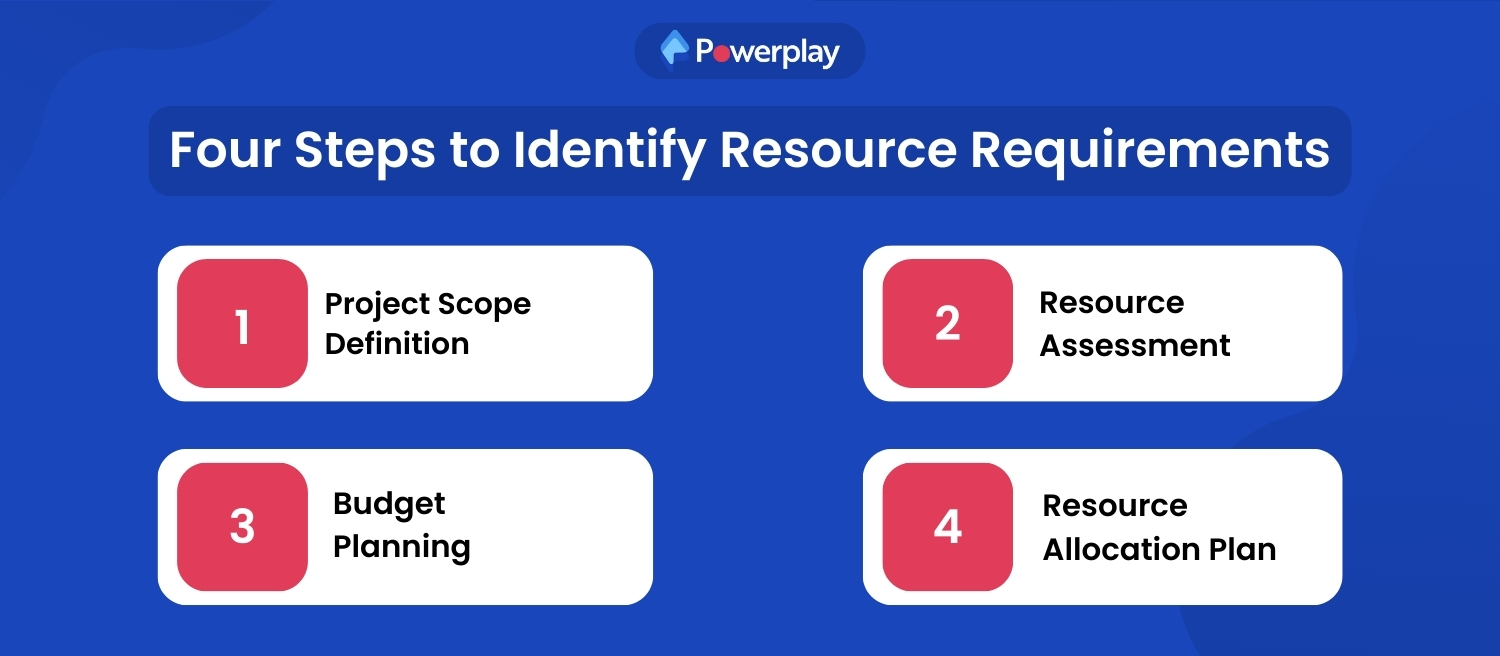
- Project Scope Definition: Clearly define the project’s goals and requirements.
- Resource Assessment: Identify the necessary labor, materials, equipment, and time.
- Budget Planning: Develop a detailed budget covering all resource costs.
- Resource Allocation Plan: Create a plan for the efficient distribution and use of resources.
Best Practices for Effective Construction Resource Management
- Detailed Planning: Develop comprehensive resource management plans.
- Regular Monitoring: Continuously track resource usage and availability.
- Communication: Maintain open lines of communication among all stakeholders.
- Technology Utilisation: Employ software tools for better resource management. Utilising resource management software can significantly enhance the efficiency of managing construction resources, including allocation, scheduling, visibility, and cost control.
Construction Resource Management Process
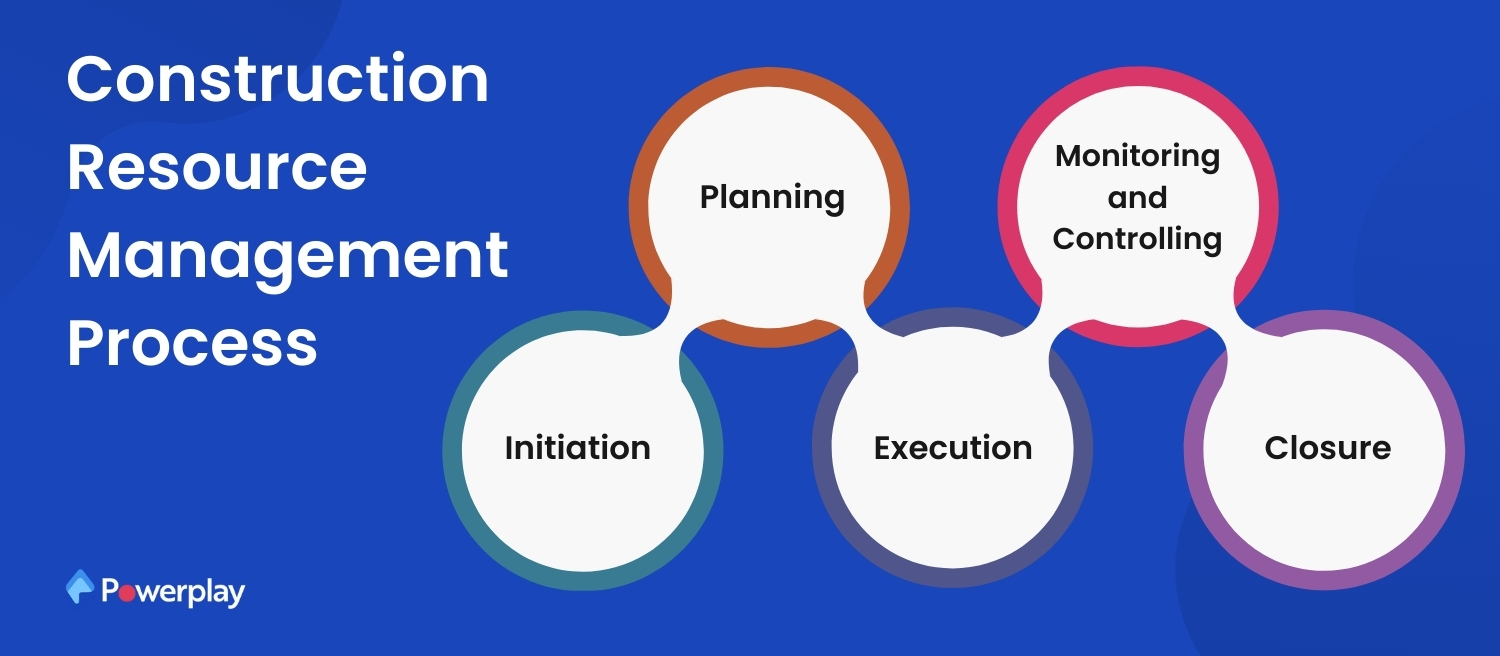
Effective construction resource management involves a structured approach to ensure resources are optimally utilised throughout the project lifecycle. Here’s a detailed breakdown of the construction resource management process:
1. Initiation
The initiation phase marks the beginning of the construction project. It is crucial to start with a clear project brief and conduct a thorough resource assessment. Key activities include:
- Project Brief: Define project objectives, scope, timelines, and budgetary constraints. This sets the foundation for resource planning.
- Resource Assessment: Evaluate and identify the necessary resources for the project. This includes labor requirements, materials, equipment, and any other resources essential for project execution.
- Stakeholder Identification: Identify all stakeholders involved in resource management, including project managers, contractors, suppliers, and subcontractors. Establish communication channels and responsibilities.
2. Planning
During the planning phase, detailed plans are developed to effectively allocate and schedule resources. Key activities include:
- Resource Allocation Plan: Allocate resources based on project requirements and timelines. This involves determining the quantity and type of resources needed at each phase of the project.
- Scheduling: Create a comprehensive schedule that aligns resource availability with project milestones. Utilise project management tools like Gantt charts to visualise tasks and resource dependencies.
- Budget Planning: Develop a detailed budget that outlines resource costs, including labour, materials, equipment rental or purchase, and contingency funds for unforeseen expenses.
- Risk Assessment: Conduct a risk assessment to identify potential resource-related risks such as shortages, delays in material delivery, or labor disputes. Develop contingency plans to mitigate these risks.
3. Execution
The execution phase involves implementing the resource plans developed during the planning stage. Key activities include:
- Resource Deployment: Deploy resources according to the allocated plan. Ensure that labor, materials, and equipment are mobilised to the project site as scheduled.
- Task Execution: Supervise and coordinate tasks to ensure resources are used efficiently. Monitor progress against the project schedule and make adjustments as necessary to optimise resource utilisation.
- Quality Control: Implement quality assurance measures to ensure that resources are used in accordance with project specifications and standards. Conduct regular inspections and quality checks to maintain high-quality workmanship.
4. Monitoring and Controlling
Continuous monitoring and control are essential to track resource use and make timely adjustments. Key activities include:
- Progress Tracking: Monitor the progress of tasks and resource consumption in real-time. Use project management software to track resource utilisation against planned allocations.
- Performance Evaluation: Evaluate resource performance and productivity. Identify any inefficiencies or deviations from the plan and take corrective actions to address them promptly.
- Change Management: Manage changes in resource requirements or project scope. Assess the impact of changes on resource allocation and adjust plans accordingly.
- Communication: Maintain open communication channels with stakeholders to provide updates on resource status, address issues, and ensure alignment with project goals.
5. Closure
The closure phase marks the conclusion of the construction project and involves finalizing resource management activities. Key activities include:
- Resource Audit: Conduct a comprehensive audit of all resources used throughout the project. Verify that resource consumption aligns with planned allocations and budgetary constraints.
- Documentation: Document lessons learned and best practices from resource management activities. Capture insights into what worked well and areas for improvement in future projects.
- Handover: Prepare for the handover of resources, equipment, and documentation to stakeholders or facility management teams. Ensure all contractual obligations related to resource management are fulfilled.
- Project Review: Conduct a post-project review with key stakeholders to assess overall project performance, including resource management. Gather feedback to inform future resource planning and management strategies.
Resource Planning Template
A Resource Plan Template is a pre-designed document that provides a framework for creating a resource plan. It includes sections for listing all necessary resources, their availability, and their allocation over the project timeline. Using a project resource plan template saves time and ensures consistency across all projects, making it simplier to manage resources and keep track of their usage.
You can use our comprehensive Resource Plan Template to
- Simplify the process
- Get clear overview of all resources involved in your project
- Optimise Project Budget
Download Free Resource Planning Template
Construction Resource Management Templates
- Gantt Charts: For scheduling tasks and resources.
- Resource Allocation Matrix: To track resource distribution.
- Budget Templates: For detailed cost tracking.
How Powerplay Helps With Construction Resource Management
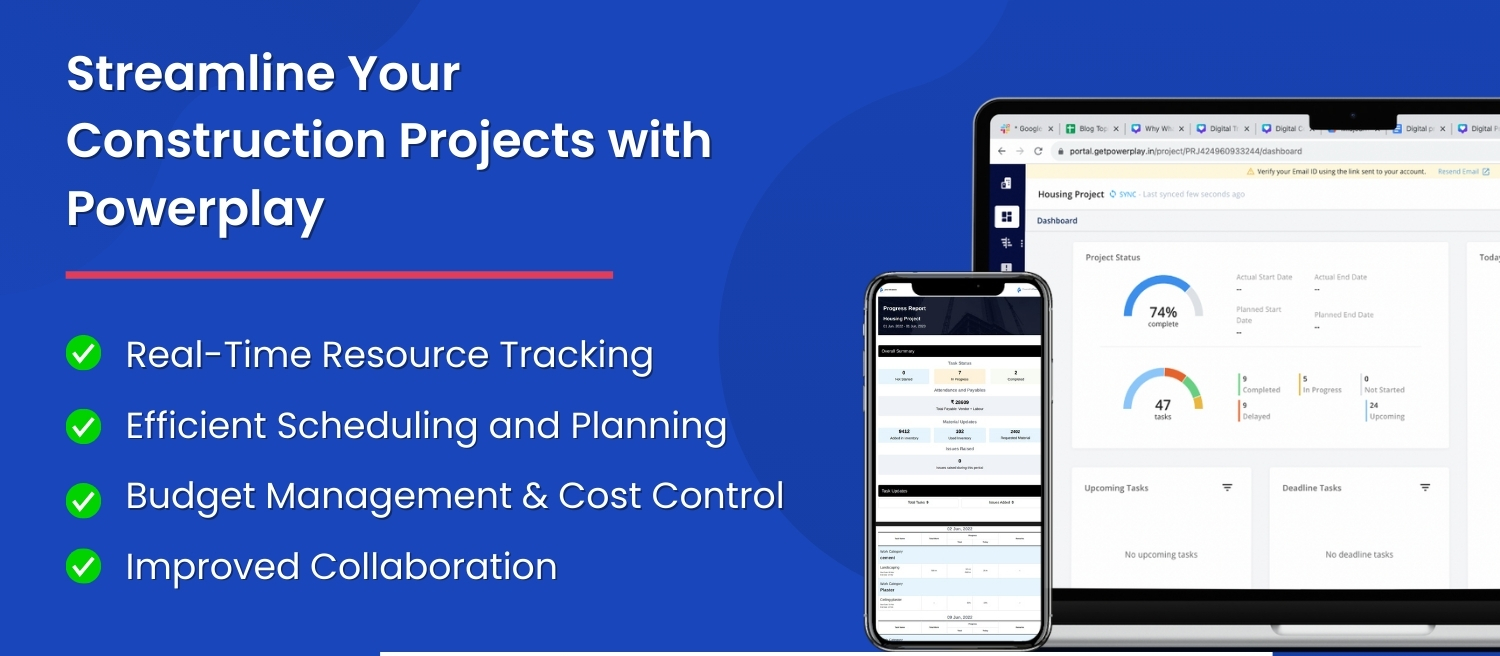
Effective construction resource management is essential for the successful completion of any construction project. Powerplay, a comprehensive construction management software, offers a suite of tools and features designed to streamline and optimise resource management. Project managers can leverage Powerplay to tackle the challenges of managing various resources, including labour, ensuring project completion and budget adherence. Here’s how Powerplay helps in managing construction resources efficiently:
Real-Time Resource Tracking
One of the standout features of Powerplay is its ability to track resources in real time. This capability ensures that project managers have up-to-the-minute information on the status and location of materials, equipment, and labor. Here’s how real-time tracking benefits construction projects:
- Enhanced Visibility: Managers can instantly see where resources are being utilised and identify any areas where there might be shortages or surpluses.
- Quick Decision-Making: Real-time data allows for swift adjustments to resource allocation, preventing delays and minimising downtime.
- Improved Accountability: With real-time tracking, it’s easier to hold teams accountable for resource usage, ensuring that materials and equipment are used efficiently and effectively.
Efficient Scheduling and Planning
Powerplay’s advanced scheduling tools help construction managers plan and allocate resources more effectively. By integrating project timelines with resource availability, Powerplay ensures that projects stay on schedule. Key features include:
- Gantt Charts and Calendars: Visual tools like Gantt charts and calendars make it easy to plan tasks and allocate resources over time. These tools help in identifying potential conflicts and adjusting schedules proactively.
- Automated Alerts and Notifications: Powerplay can send automated alerts and notifications about upcoming tasks and resource needs, ensuring that nothing falls through the cracks.
- Resource Optimisation: By analysing past project data, Powerplay helps managers optimise resource allocation, ensuring that labor, materials, and equipment are used where they are needed most.
Budget Management and Cost Control
Staying within budget is a critical aspect of construction resource management. Powerplay offers robust budgeting and cost control features to help manage expenses and prevent budget overruns:
- Detailed Cost Tracking: Powerplay allows for detailed tracking of all project costs, from labor and materials to equipment and subcontractor expenses. This level of detail helps in monitoring and controlling project budgets.
- Expense Forecasting: The software’s predictive analytics can forecast future expenses based on current spending patterns, helping managers anticipate and prepare for potential cost overruns.
- Budget Reports: Powerplay generates comprehensive budget reports that provide insights into where money is being spent and identify areas where cost savings can be achieved.
Improved Collaboration and Communication
Effective communication and collaboration are vital for successful resource management. Powerplay enhances team collaboration through several key features:
- Centralised Communication: Powerplay provides a centralised platform for all project-related communications, ensuring that everyone is on the same page.
- Document Sharing: Easy sharing and access to important documents, such as blueprints, contracts, and resource plans, streamline collaboration among team members and stakeholders.
- Stakeholder Updates: The software can automatically generate and distribute updates to stakeholders, keeping them informed about resource allocation and project progress.
Conclusion
Effective construction resource management is pivotal for the success of any construction project. By understanding and implementing both operational and strategic resource management practices, you can ensure that your projects are completed on time, within budget, and to the highest quality standards. The various templates and best practices outlined in this guide provide a robust framework to streamline the resource management process. Tools like Powerplay can further enhance your capabilities, offering real-time insights and efficient resource allocation. Embracing these strategies will lead to improved efficiency, reduced costs, and ultimately, successful project outcomes.













